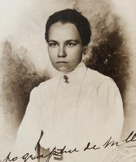Anna Hedvig Büll facts for kids
Anna Hedvig Büll (born Anna Hedwig Bühl, 4 February 1887 – 3 October 1981) was a brave missionary from Estonia. She helped save thousands of Armenian children and women during a very difficult time called the Armenian genocide.
Contents
Early Life and a Special Calling
Anna Hedvig Büll was born in 1887 in Haapsalu, Estonia. At that time, Estonia was part of the Russian Empire. Her family was German and followed the Lutheran faith. Her father owned a special health resort in their town. Anna was one of eight children.
She went to a local school until she was 15. Then, she continued her studies in Saint Petersburg, Russia, at a German Lutheran school. In 1903, while visiting her family, she heard a talk by a speaker named Johann Kargel. This talk inspired her to dedicate her life to helping others through humanitarian missions.
Learning to Help Others
After finishing her college degree in 1903, Anna spent time at a mission school in Germany. There, she learned about the challenges faced by Armenians in the Ottoman Empire. She really wanted to help the Armenian people. So, she continued her studies at a school for missionaries.
She was soon invited to work at an Armenian mission station in Maraş. However, because she was still young, she first worked with women and children in German villages. Later, she spent a few months helping people in need in Saint Petersburg.
Working with Armenian Communities
In 1909, Anna tried again to go and work with Armenians. But her trip was delayed because of a difficult situation in a place called Cilicia. Instead, Anna spent two years at a special school training to be a missionary teacher.
Helping Children in Maraş
After finishing her studies, Anna finally went to Cilicia. From 1911 to 1916, she worked as a teacher at an Armenian orphanage in Maraş. In 1915, she saw the terrible events of the Armenian genocide happening in Cilicia. She played a very important role in saving the lives of about two thousand Armenian children and women. Maraş became known as "The City of Orphans" because of all the children who had lost their families. Anna was called back from Maraş in 1916.
A New Start in Syria
In 1921, after a long stay in Austria to care for an aunt, Anna returned to Estonia. She took care of family matters and became a citizen of the newly independent country. Later in 1921, a new organization called Action Chrétienne en Orient sent Anna to Aleppo, Syria.
Building a Safe Place for Survivors
In Aleppo, Anna set up a refugee camp for the people who had survived the Armenian genocide. She also organized medical help for people suffering from a serious illness and helped build two hospitals. Anna worked hard to create weaving shops, gardens, and an Armenian language school. These projects helped the refugees build better lives for themselves.
Later Life and Lasting Memory
In 1951, many of the refugees Anna had helped moved to Soviet Armenia. However, the Soviet authorities did not allow Anna to get a visa to join them. She was also not allowed to return to her home country of Estonia, which had been taken over by the USSR.
Anna became a refugee herself. She moved to Europe and continued her charitable work in France, Switzerland, and Germany. She lived the rest of her life there, always keeping her Estonian citizenship.
Remembering Anna Büll
Anna Büll passed away on 3 October 1981, near Heidelberg, Germany. She had spent more than 40 years of her life working to improve the lives of Armenian refugees.
On 29 April 1989, a special plaque was placed on her birth house in Haapsalu, Estonia, by the Armenian-Estonian Cultural Society. Her memory is also honored with a monument in Armenia and at the Armenian Genocide Museum in Yerevan. Among the refugees she helped, and in Armenia, she is sometimes called the Mother of Armenians.
Anna Hedvig Büll's life, along with four other European women who witnessed the Armenian genocide, is featured in the 2015 film Map of Salvation.
See also
- Witnesses and testimonies of the Armenian genocide



